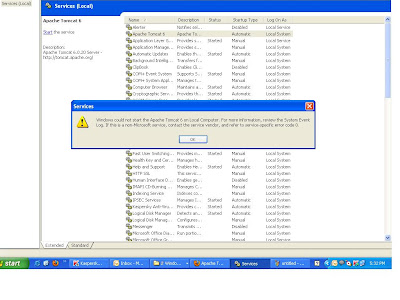How to Recover Oracle 10G Database Using Data Files-Redo logs-Control files during OS failure
Hi Guys,
Many times we have seen that when the operating system get failure due to something miss
happening or miss handled with the system and the system contains the very important databases
which you don't wanna loose at any cost and you do not have any
backup for that. So I am writing this technique how to recover the Oracle 10G
database on this situation. It is very interesting & the easiest way to
recover the database.If something like this happened with you then don't worry
go with the below mentioned steps and restore your database:
For recovering the database we have
to need following files.
1. Database datafiles
2. Control files
3. Redologs
4. Parameter files
5. Other database
related files
Database datafiles:
Database data files are physical
files which are stored on secondary memory. These files are used to store the physical data.
Database data files are only written by the Oracle DB Writer. These physical
data files are associated with Oracle Tablespaces which are logical containers
for tables and indexes. Database datafiles are basically located on path D:\oracle\
product\10.2.0\oradata\sid\
Example of datafiles:
DR01.DBF, INDX01.DBF,
TOOLS01.DBF, TEMP01.DBF, SYSTEM01.DBF, USERS01.DBF, RBS01.DBF & .ORA
Control Files:
The Control files of the database is
a binary file that contains the essential information about the database. The control
files contains the information like database name, database log files.Without
control files Oracle cannot works it is mandatory for database.Because the control files are so important & Oracle allows you to maintain duplicate copies of the control files.
control files Oracle cannot works it is mandatory for database.Because the control files are so important & Oracle allows you to maintain duplicate copies of the control files.
These control files are located
on D:\product\10.2.0\oradata\sid\
Example of Control Files:
CONTROL01.CTL,
CONTROL02.CTL,CONTROL03.CTL
Online redo logs concepts:
Online redo logs like a tape
recorder that records every change in the Oracle database. As modification occur,
they are continuously recorded in the online redo logs.
Oracle requires
two online redo logs which are assigned to the database. Oracle writes the redo to the
first log and when the first log is full then Oracle will switch to the second log
and write the same redo logs.
Redologs are also located on the
same path where the control & datafiles resides d:\ oracle\
product\10.2.0\oradata \sid\
Examples of
Redologs:
REDO01.LOG, REDO02.LOG,
REDO03.LOG
Oracle Parameter file
Concepts:
The parameter file
(also called init.ora) contains configuration information for the database to
use at startup time. The parameter file you configure how much RAM the database
is use, where to find the control files, where to write trace file,alert file
and a whole host of other information. Many times the oracle database will not
start without a parameter file. Oracle also allows you to have a manual parameter
file (called a PFILE) or a server-side parameter file (called a
SPFILE). Parameter file is located on path D:\oracle\ product\10.2.0\admin\sid\pfile\
init.ora
Steps for recovering the database:
1. After installing the fresh operating system you have to
installed oracle 10G on the same drive again where the Oracle were installed earlier for the easy recovery of the database.
2. But before new
installation of oracle engine take the backup of all required files which are
mentioned below.
init.ora from D:\oracle\ product\10.2.0\admin\sid\pfile\,
init.ora from D:\oracle\ product\10.2.0\admin\sid\pfile\,
pwdSID from D:\ oracle\product\10.2.0\db_1\database\.
Redologs(REDO01.LOG,
REDO02.LOG, REDO03.LOG),
Control files
(CONTROL01.CTL, CONTROL02.CTL,CONTROL03.CTL ) &
.DBF(DR01.DBF,INDX01.DBF,TOOLS01.DBF,TEMP01.DBF, SYSTEM01.DBF, USERS01.DBF,RBS01.DBF)&.ORA
files from D:\oracle \ product\10.2.0\oradata\
3. Now
place the all backup files on below mentioned path
Place
Redologs,Control files & .DBF & .ORA files on location D:\oracle\ product\10.2.0
\oradata\
init.ora on location
D:\oracle\ product\10.2.0\admin\sid\pfile\
and
PWDSID.ora on
location D:\ oracle\product\10.2.0\db_1\database\.
4. And then restart
the oracle services and run the SQL console.
Hope this will help You.
Have a nice Day....
Regards,
Sampan

Oracle 11g XML Developer Online Training
ReplyDeleteOracle SOA/BPEL 11g Online Training
Oracle Golden Gate 11g Online Training
Oracle Fusion Middleware 11g Online Training
Oracle Directory Services 11g Online Training
Oracle SOA Suite 11g -
http://www.21cssindia.com/courses/oracle-11g-xml-developer-online-training-121.html
Basic Concepts and Architecture - Overview of service-oriented architecture (SOA) - Overview XML, XSD, X Path, XSLT, SOAP, WSDL, UDDI - The basic concepts of Oracle BPEL Process Manager - BPEL Process Manager components - Installation - Overview of the fusion architecture - Overview of the Web logic server -